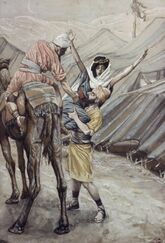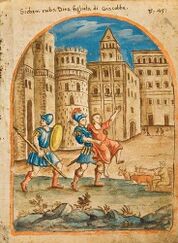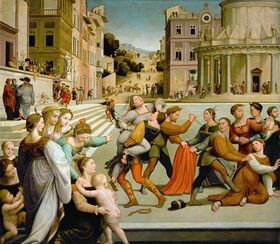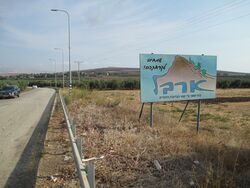أربل
Arbel
אַרְבֵּל | |
|---|---|
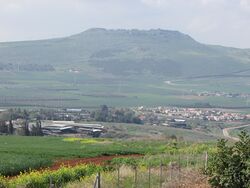 | |
| الإحداثيات: 32°48′44″N 35°28′57″E / 32.81222°N 35.48250°E | |
| Grid position | 195/246 PAL |
| المجلس | Lower Galilee Regional Council |
| Founded | 1949 |
| أسسها | Demobilized IDF Soldiers |
| التعداد (2019)[1] | 735 |
Arbel (بالعبرية: אַרְבֵּל) is a moshav in northern Israel. Located beside Mount Arbel next to the Sea of Galilee near Tiberias, it falls under the jurisdiction of Lower Galilee Regional Council. In 2019 its population was 735.[1]
Arbel was established in 1949 by demobilized soldiers on the lands of the depopulated Arab-Palestinian village of Hittin.[2] It was initially a moshav shitufi, but became a moshav ovdim in 1959.
التاريخ
"أربل" أو "أربلا" الهلينية والرومانية والبيزنطية
In 161 BCE "Arbela" in the Arbel Valley was the site of a battle between the supporters of the Maccabees and Seleucid general Bacchides, who defeated and killed his opponents (Macc.%209:2&verse={{{3}}}&src=! 1 Macc. 9:2 {{{3}}}).[3][4][5]
In the second half of the second century BCE, the village of Arbel was the home of the sage Nittai of Arbela.[بحاجة لمصدر]
In 38 BCE, Jewish partisans of Antigonus who were opposing Herod in his conquest of the land with the help of Roman, sought refuge from his troops in the caves dotting the steep northern cliffs of Mount Arbel, but couldn't escape death.[6][4][5] Their story is told by Josephus, who himself fortified the cave-village as a storage base at the beginning of the First Jewish–Roman War against Rome in 66 CE.[4][5]
The ancient town of Arbel is thought by some to have been located at the site of Khirbet Wadi Hamam ("Ruins [in the] Valley of the Doves"; Hurvat Vradim being the modern Hebrew name), on the other side of Arbel Valley, on the eastern slopes of Mount Nitay and close to the stream bed; if that was the case, the village only moved to the site of Khirbet Irbid, close to where the modern moshav stands now, during the Middle Ages.[5] The Jewish scholar Ishtori Haparchi, writing in 1322, thought to identify ancient Arbel with the Arab village itself, in its location on Mount Arbel, 4.5 kilometres (2.8 mi) northwest of Tiberias.[7]
Ceramics from the late Roman and Byzantine periods have been found.[8]أين بالضبط؟ خربة إربد؟ خربة وادي حمام؟ في مكان آخر في المنطقة؟[محل شك]
ثم رواية يهودية من القرن الثاني عشر الميلادي أن دينا مدفونة في أربل.[9]
"إربل" المسلمة المبكرة
In 1047 CE, Nasir Khusraw was on a pilgrimage through Palestine, and noted that he came to the village of Irbil, after leaving Hittin, on his way to Tabariyyah. He further noted that "on the south side of [Irbil] rises a mountain; and on the mountain is an enclosure, which same contains four graves-those of the sons of Yacub (Jacob) - .[..] -who were brothers of Yusuff (Joseph) [..] And going onward I came to a hill, and below the hill a cavern, in which was the tomb of the mother of Moses."[10]
"إربد" العثمانية، ثم "خربة إربد"
In 1517, the village was incorporated into the Ottoman Empire with the rest of Palestine, and in 1596, Irbid appeared in Ottoman tax registers as being in nahiya (subdistrict) of Tabariyya under the liwa' (district) of Safad. It had a population of 2 households, both Muslims. They paid taxes on wheat, barley, summer crops, cotton, goats and/or beehives, olive oil press and/or a press for grape syrup.[11]
The caves on the steep northern cliffs of Mount Arbel were refortified into a cave castle by Ali Beg, the son of 17th-century Druze ruler Fakhr ad-Din al-Maani.[5][4]
In 1875, the French explorer Victor Guérin visited the ruins,[12] and in 1881, the Palestine Exploration Fund's Survey of Western Palestine found at "Kh. Irbid"[13] "important ruins", with "traces of an Arab village".[14]
"موشاڤ آربل" الإسرائيلي
By 1948, the land belonged to the Arab village of Hittin, which was depopulated in the 1948 Arab–Israeli War.[2] Arbel was established in 1949 by demobilized soldiers.[2] Initially a moshav shitufi (a more socialist-type moshav, closer to the kibbutz model), Arbel became a moshav ovdim in 1959.
الكنيس القديم
Arbel is notable for the ruins of an ancient synagogue, which stands amid the remnants of an ancient Jewish village on the western edge of the moshav. Archaeologists concluded that it was built in the fourth century CE, shows at least two construction phases, being rebuilt in the sixth century, and was probably used continuously until the eighth century, when a conflagration finally destroyed it—probably connected to the catastrophic 749 earthquake.[5] The door of the synagogue, still standing, was carved from a massive natural outcropping of limestone, and the synagogue itself situated so as to make use of the stone as a handsome door. It is carved with decorative floral motifs and medallions. A carved groove for a mezuzah can be seen. Three sides of the building had carved stone benches. The two-storey building had three rows of columns with Corinthian capitals on the first floor and Ionic capitals on the second.[15]
سكان بارزون
- Shay Avital (born in 1952), Israeli Major General (Ret.) and former head of the Special Operations Forces Command
انظر أيضاً
المراجع
- ^ أ ب "Population in the Localities 2019" (XLS). Israel Central Bureau of Statistics. Retrieved 16 August 2020.
- ^ أ ب ت Khalidi, 1992, p. 523
- ^ Negev, Avraham; Gibson, Shimon (2001). Arbel, Arbela. New York and London: Continuum. p. 47. ISBN 0-8264-1316-1.
{{cite book}}:|work=ignored (help) - ^ أ ب ت ث Jerome Murphy-O'Connor (2008). The Holy Land: An Oxford Archaeological Guide from Earliest Times to 1700. Oxford Archaeological Guides. Oxford: Oxford University Press. ISBN 978-0-19-923666-4. Retrieved 17 July 2019.
- ^ أ ب ت ث ج ح Arbel National Park and Nature Reserve, at the website of the Israel Nature and Parks Authority, accessed 17 July 2019
- ^ Josephus Flavius, translated by G.A Williamson, The Jewish War, Penguin Books Ltd, 1959, p.62 - 63
- ^ Ishtori Haparchi, Kaftor wa-Ferach vol. 2, (3rd edition, published by ed. Avraham Yosef Havatzelet), chapter 11, Jerusalem 2007, p. 54 (note 29) (Hebrew).
- ^ Dauphin, 1998, pp. 718-719
- ^ "عثر الباحثون على مقابر عشائرية في أربل - ربما يضم قبر دينا". NRG.
- ^ Khusraw, 1897, p.16
- ^ Hütteroth and Abdulfattah, 1977, p. 190
- ^ Guérin, 1880, pp. 198-201
- ^ "The ruin of Irbid", according to Palmer, 1881, p. 128
- ^ Conder and Kitchener, 1881, SWP I, pp. 396-400
- ^ Ancient Synagogues in the Land of Israel, Mordechai Aviam, Israel Nature and Parks Authority, 1997, p. 16
ببليوجرافيا
- Conder, C.R.; Kitchener, H.H. (1881). The Survey of Western Palestine: Memoirs of the Topography, Orography, Hydrography, and Archaeology. Vol. 1. London: Committee of the Palestine Exploration Fund.
- Dauphin, C. (1998). La Palestine byzantine, Peuplement et Populations. BAR International Series 726 (in French). Vol. III : Catalogue. Oxford: Archeopress. ISBN 0-860549-05-4.
{{cite book}}: CS1 maint: unrecognized language (link) - Hütteroth, Wolf-Dieter; Abdulfattah, Kamal (1977). Historical Geography of Palestine, Transjordan and Southern Syria in the Late 16th Century. Erlanger Geographische Arbeiten, Sonderband 5. Erlangen, Germany: Vorstand der Fränkischen Geographischen Gesellschaft. ISBN 3-920405-41-2.
- Khalidi, W. (1992). All That Remains: The Palestinian Villages Occupied and Depopulated by Israel in 1948. Washington D.C.: Institute for Palestine Studies. ISBN 0-88728-224-5.
- Nasir-I-Khusrau; et al. (1897). Vol IV. A journey through Syria and Palestine (1047 CE.). The pilgrimage of Saewolf to Jerusalem. The pilgrimage of the Russian abbot Daniel. London: Palestine Pilgrims' Text Society.
- Guérin, V. (1880). Description Géographique Historique et Archéologique de la Palestine. Vol 3, Galilee, pt. 1.
- Palmer, E.H. (1881). The Survey of Western Palestine: Arabic and English Name Lists Collected During the Survey by Lieutenants Conder and Kitchener, R. E. Transliterated and Explained by E.H. Palmer. Committee of the Palestine Exploration Fund.
وصلات خارجية
- Survey of Western Palestine, Map 6: IAA, Wikimedia commons
- Pages using gadget WikiMiniAtlas
- CS1 errors: periodical ignored
- Short description is different from Wikidata
- Coordinates on Wikidata
- Pages using infobox settlement with missing country
- Articles containing عبرية-language text
- Articles with unsourced statements from July 2019
- مقالات ذات عبارات محل شك
- موشاڤيم
- أماكن مأهولة تأسست في 1949
- مواقع أثرية في إسرائيل
- أماكن مأهولة سابقاً في جنوب غرب آسيا
- Ancient synagogues in the Land of Israel
- أماكن مأهولة في المنطقة الشمالية (إسرائيل)
- تأسيسات 1949 في إسرائيل
- Ancient Jewish settlements of Galilee
- بحيرة طبريا

